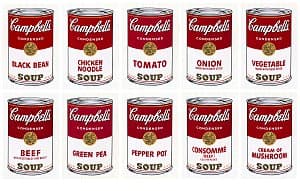

Andy Warhol
Learn moreCampbell's Soup I 1968
© The Andy Warhol Foundation for the Visual Arts, Inc./ARS. Licensed by Copyright Agency The Poynton Bequest 2006
More detail | PermalinkThe series Campbell Soup I 1968 represents an important contribution by Andy Warhol to Pop art. In this group of 10 colour screenprints Warhol takes something that is commonplace and sets it in a fine art context—the ever-present humble can of condensed Campbell’s soup (something his mother fed him as a child, and which the artist continued to have for lunch). In the postwar baby boom era, the Campbell’s brand had targeted a housewife’s social aspirations, taking its product from the merely tasty to tasteful. Warhol’s subject combined a mixed message of the deadpan and social mobility in an art context.[1] The surprise effect of a subject for art that is familiar and uninspiring has its origins in the earlier Dada movement and works such as Marcel Duchamp’s ready-made Fountain 1917, where he placed a urinal in a gallery and gave it a new title. As Pop art emerged as a style in the United States from the late 1950s, it was also termed ‘Neo-Dada’ by some early commentators.
After Warhol’s initial openness about coming from the commercial art world, he found this background impeded his acceptance as a serious artist. He approached the Leo Castelli Gallery in New York with the hope that this newly established venue might include him in the stable of young emerging artists. Warhol was dismayed to learn of Roy Lichtenstein’s comic strip subject matter—something Warhol himself began painting about a year before Lichtenstein. Castelli rebuffed his overtures because of the similarity and his view that Warhol’s work was lifeless and cold in comparison.
Frustrated by his rejection, a distraught Warhol turned to Campbell’s soup cans as a suitable subject for his art. He lamented that ‘It’s too late for the cartoons. I’ve got to do something that will have a lot of impact, that will be different from Lichtenstein and Rosenquist’.[2] Warhol asked his friend and gallery director Muriel Latow what subject he should choose (as he often did with friends and colleagues) and she proposed that, along with money, he should choose a subject, ‘that everybody sees every day, that everybody recognises … like a can of soup’.[3] In 1962, Warhol painted his Campbell’s soup cans, which astonished the art world—gaining instant notoriety when shown at Irving Blum’s Ferus Gallery in Los Angeles, where 32 soup varieties were displayed on a shelf to mimic their origins.
Warhol continued to develop this theme and made many versions including this group of 10 prints produced during 1968, with different soup flavours drawn from the original 32. The repetitive nature of his compositions suggests an art of the assembly line. Warhol’s expressed ideal, in fact, was to make use of the mass production technique of screenprinting to create his imagery. This series is at the same time banal, acerbic, yet mesmerising.
Jane Kinsman
1
[1] For further discussion on Warhol’s approach to brands and the status of Campbell’s soup see Anthony E Grudin, Warhol’s working class: Pop Art and egalitarianism, The University of Chicago Press, Chicago and London, 2017, pp 76, 97–9.
[2] Muriel Latow, quoted in Victor Bockris, Warhol, Frederick Muller, London, 1989, p 143.
[3] As above.

